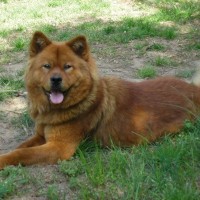Appearance of the Akita Chow
|
| The Akita Chow is a hybrid of the Akita Inu and the Chow Chow, weighing on average between 40 and 66 kilos and measuring between 58.5 and 63.5 centimeters, depending on the size of its parents. Like its parents, the Akita Chow's body is strong and robust, and of great size. Majestic and attractive, grooming will be important as both parents have thick coats. The Akita Chow's coat is long, straight and thick, and comes in fawn, silver, white, brown, red and black. The Akita Chow tends to have a round face with almond-shaped eyes. The tip of its nose is black and its head features upright ears. |
Temperament of the Akita Chow
|
| Like its parents, the Akita Chow is independent and can even be obstinate. They are intelligent, very loyal and possessive of their owners, but are not known for being overly affectionate. If you prefer a dog that doesn't jump on you or lick your face, the Akita Chow is a good choice. Akita Chows are protective dogs and can, therefore, have a dominant behavior on humans and animals. If not properly socialized, they will be aggressive towards strangers, with whom they are generally uncomfortable. Caution should be exercised when your dog is around children, due to its large size and authoritarian tendencies. Older children can be taught to stand their ground with kindness but firmness, while younger ones may feel shy and a little overwhelmed by this large breed, which can sometimes be quite noticeable. |
Needs and activities of the Akita Chow
|
| The Akita Chow is a large, independent-thinking dog. He'll need plenty of daily exercise. He'll appreciate a long run or a walk on a leash. It will be useful to have a fenced-in yard where he can run and play to his heart's content in complete safety. While the Akita Inu is a very energetic dog, the Chow Chow tends to be a little lazy; your Akita Chow can fall anywhere on this continuum. No matter how motivated, or unmotivated, your Akita Chow is to exercise, he needs it to stay healthy. |
Maintenance of the Akita Chow
|
| The Akita Chow's thick coat needs regular brushing, 3 to 4 times a week, to keep it clean and healthy. Your Akita Chow's nails should be trimmed if necessary and its teeth brushed regularly to ensure long-term dental health. As the Akita Chow can be stubborn, training can be difficult. A training program based on reward and positive reinforcement can begin as soon as you bring your young dog home. Socializing your Akita Chow is also important. It's best to socialize him first with a small group before introducing him to larger groups. Use touch and treats to reinforce positive behavior in the presence of others and help him accept people and dogs. It's also important to teach your Akita Chow obedience. You can start by teaching your dog to accept your guidance. This will help him feel more confident that someone else is in charge, and help him think before showing aggressive behavior. |









 English (United Kingdom)
English (United Kingdom)